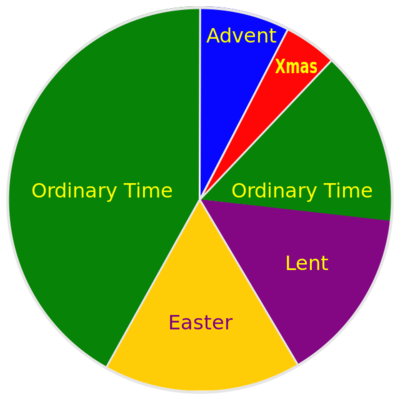Christmas season: Difference between revisions
No edit summary |
No edit summary |
||
| Line 25: | Line 25: | ||
|- | |- | ||
| 25 December | | 25 December | ||
| 1 | |align="right"| 1 | ||
|- | |- | ||
| 26 | | 26 | ||
| 2 | |align="right"| 2 | ||
|- | |- | ||
| 27 | | 27 | ||
| 3 | |align="right"| 3 | ||
|- | |- | ||
| 28 | | 28 | ||
| 4 | |align="right"| 4 | ||
|- | |- | ||
| 29 | | 29 | ||
| 5 | |align="right"| 5 | ||
|- | |- | ||
| 30 | | 30 | ||
| 6 | |align="right"| 6 | ||
|- | |- | ||
| 31 | | 31 | ||
| 7 | |align="right"| 7 | ||
|- | |- | ||
| 1 January | | 1 January | ||
| 8 | |align="right"| 8 | ||
|- | |- | ||
| 2 | | 2 | ||
| 9 | |align="right"| 9 | ||
|- | |- | ||
| 3 | | 3 | ||
| 10 | |align="right"| 10 | ||
|- | |- | ||
| 4 | | 4 | ||
| 11 | |align="right"| 11 | ||
|- | |- | ||
| 5 | | 5 | ||
| 12 | |align="right"| 12 | ||
|} | |} | ||
</div> | </div> | ||
Revision as of 18:10, 6 January 2011

The Christmas season lasts from Christmas Day until the Feast of the Baptism of the Lord.
| December 25 | Christmas Day |
| January 1 | Octave of Christmas; Solemnity of Mary Mother of God |
| December 25 - January 5 | Twelve Days of Christmas |
| January 6 | Epiphany |
| Sunday after Epiphany | Baptism of the Lord |
| 25 December | 1 |
| 26 | 2 |
| 27 | 3 |
| 28 | 4 |
| 29 | 5 |
| 30 | 6 |
| 31 | 7 |
| 1 January | 8 |
| 2 | 9 |
| 3 | 10 |
| 4 | 11 |
| 5 | 12 |
Xmas
The first letter of this ancient abbreviation is not the English character "X" but the Greek character Chi. It is the first letter of "Christos" in Greek: Χριστος. People who use this abbreviation (as I did in the pie chart of the liturgical year) are not "Xing" Christ out of Christmas; they are going back to the original language of the New Testament and to the earliest days of Christianity to find a convenient symbol for Christ.
This is an example of the problems associated with transliteration.
Historical roots
- Roman feast of Sol Invictus, "The Unconquerable Sun." The pun on "Sun/Son" does not exist in Latin, where the two words are "filius" and "sol."
- Saturnalia.
- March 25-->December 25.
Modern controversies
Christmas and Easter are traditional feasts when lapsed Catholics make a guest appearance at Mass. We hope and pray that they will "come to Church for a change."